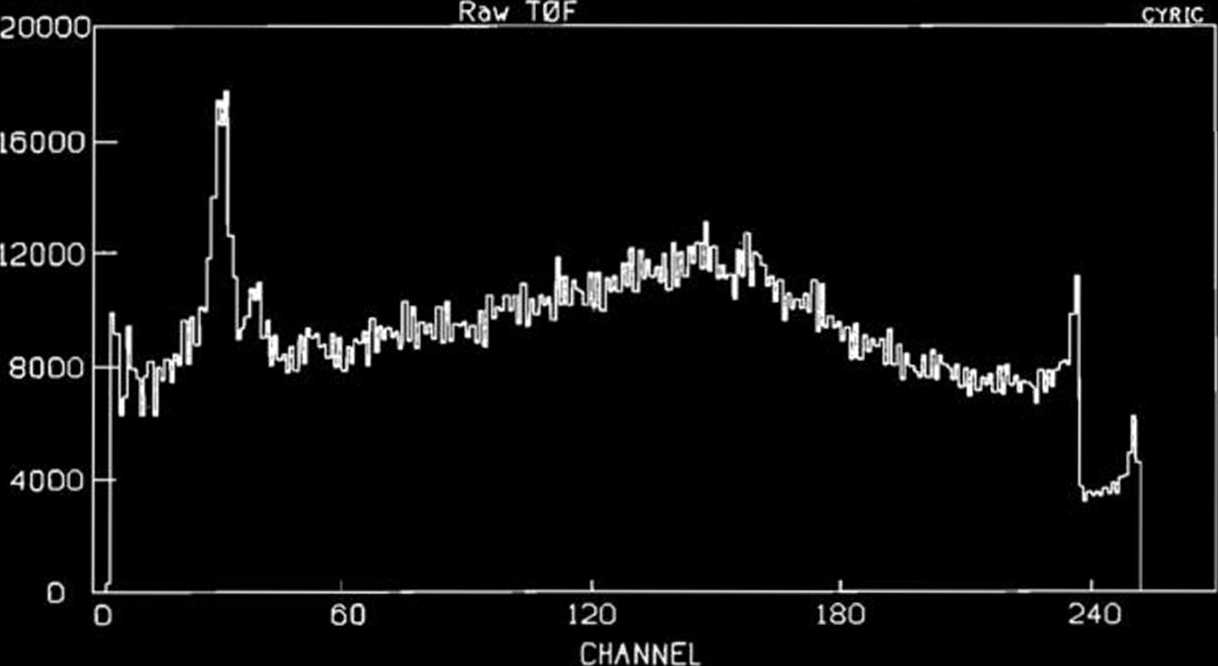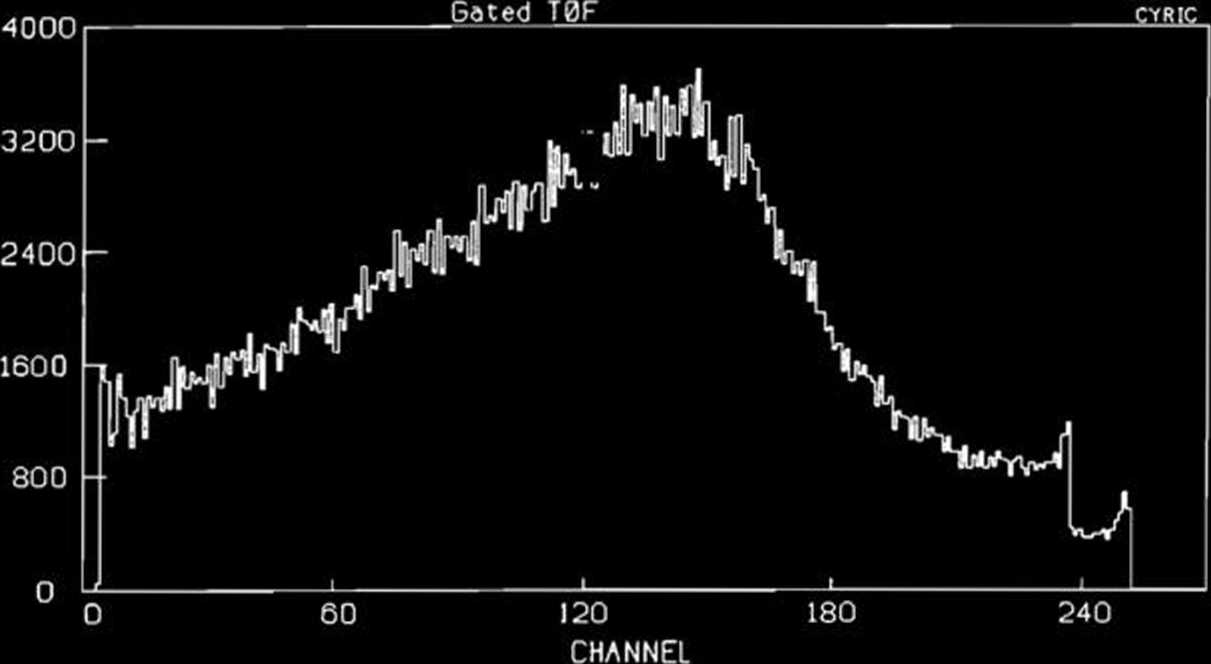372596154
121
RIKEN Accel. Próg. Rep. 24 (1990)
IM-5-23. A Test for SMART Neutron Detectors
H. Orihara, K. Hatanaka, T. Ichihara, M. Ishihara, S. Kato, H. Ohnuma, M. Ohura,
H. Okamura, H. Sakai, 'H. Shimizu, Y. Tajima, H. Toyokawa,
Y. Yano, Y. Yashiro, H.Y. Yoshida, and M. Yosoi
The SMART system,” with its beam swinger magnets, alJows neutron angular distribution mea-surements at the maximum flight path of 22 m. A test neutron time-of-flight (TOF) measurement was carried out during a SMART diagnostic run in July-August, 1990, using a 140 MeV deuteron beam and a 1 mm thick Al target. A cylindrical NE213 liquid scintillator detector, 20 cm in diameter and 5 cm in thickness, was placed at 8.6 m from the target. Stop signals were taken from the RF of the injector AVF cyclotron.
Figures l(a) and (b) show a raw TOF spectrum
RUN1013 d —» 27A1 140.00MeV 20.0deq. 20-AUG-90 16:16:08


Fig. 1. Time-of-flight spectra (a) without and (b) with the neutron gate. The fuli rangę corresponds to 80 ns. A sharp peak is due to gamma flash. The energy of the center of the broad peak is about 70 MeV, indicating this peak is due to breakup neutrons.
and a TOF spectrum gated by neutron events, respectively. Neutron-gamma discrimination was madę with a pulse-shape discriminator. The raw spectrum shows a sharp peak due to gamma flash, and a broad neutron peak due to deuteron breakup.
Pulse-height spectra corresponding to various slices of flight times ard shown in Fig. 2. One can identify a plateau extending to the heighest puse-height region due to the H(n,p) events, a bump due to the 12C(n,p) events, and a steep rise toward the Iow pulse-height region due to the 12C(n,a) and I2C(n,n')3a events.
The threshold for the neutron detection was set at about 35 MeV during the test run. The dynamie rangę was limited by the natural burst of the beam, which was 12.5 MHz. A beam chopper is necessary to obtain a wider dynamie rangę and a higher efficiency with the maximum flight path of 22 m.
Wyszukiwarka
Podobne podstrony:
121 RIKEN Accel. Próg. Rep. 24 (1990)IM-5-23. A Test for SMART Neutron Detectors H. Orihara, K. Hata
110 RIKEN Accel. Próg. Rep. 24 (1990)111-5-14. Test for Dispersive-Mode Beam Transportto the SMART
53 RIKEN Accel. Próg. Rep. 24 (1990)IM-2-19. Multiply Charged lons and Cluster lons Produced from Fr
174 RIKEN Accel. Próg. Rep. 24 (1990)V-2-20. Performance Test of Lumped NEG PumpS.R. In,1 T. Maruyam
174 RIKEN Accel. Próg. Rep. 24 (1990)V-2-20. Performance Test of Lumped NEG PumpS.R. In,1 T. Maruyam
92 RIKEN Accel. Próg. Rep. 24 (1990)111-5. Instrumentation1. Design of a Microbeamline for a Compact
94 RIKEN Accel. Próg. Rep. 24 (1990)111-5-2. Design of a Decay Muon Channel Using an Axially Symmetr
102 RIKEN Accel Próg. Rep. 24 (1990)111-5-8. Performance of Isotopic Separation in RIPS T.Nakamura,
103 RIKEN Accel. Próg. Rep. 24 (1990)111-5-9. Test Experiment of the GARIS/IGISOL K. Morita, T. Nomu
105 RIKEN Accel. Próg. Rep. 24 (1990)111-5-10. Velocity Distribution of IGISOL lon Beams M. Koizumi,
108 RIKEN Accel. Próg. Rep. 24 (1990)111-5-12. Status Report of the RIKEN Swinger-Magnetic Analyzer
116 RIKEN Accel. Próg. Rep. 24 (1990)111-5-19. Responses of Large Position-Sensitive Detectorsto Hea
RIKEN Accel. Próg. Rep. 24 (1990)111-5-25. High Speed Serial Data Link for PC-9801 J. Fujita > PC
129 RIKEN Accel. Próg. Rep. 24 (1990)IV-2. Cross Section Data for 68Ge ProductionY. Tendow, A. Hashi
132 RIKEN Accel. Próg. Rep. 24 (1990)IV-5. Cross Sections Calculated by an ALICE Codęin the A = 50 —
133 RIKEN Accel. Próg. Rep. 24 (1990)V. DEVELOPMENT OF ACCELERATOR FACILITIES1. lon Accelerator Deve
138 RIKEN Accel. Próg. Rep. 24 (1990)V-l-4. RIKEN (Japan)-RAL (U.K.) Collaboration on Muon Science R
więcej podobnych podstron